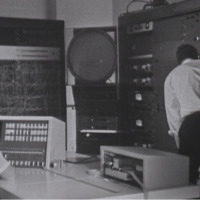| Description |
The task of today’s mathematicians and computers is to keep abreast of the fast-moving world of nuclear research where yesterday’s successful experiments can be outdated tomorrow. To record the progress being made in this complex field, television camera crews went to the Atomic Energy Commission’s Argonne National Laboratory where in the Mathematics Division men and machines are working daily to process the avalanche of data, the results of thousands experiments that are performed each year at Argonne. In this program, “Machines that think” cameras focus on the latest computers which in a matter of minutes can analyze and solve problems that would take a team of mathematicians a life time to work out. The program reports on computers that have such names as Chloe, Phylis, Engine No.2, and Analog. Chloe is a computer capable of transforming picture patterns, such as chromosome alignments, into numbers, the meaningful language of computers. In the study of radiation effects on chromosomes, for example, Chloe can come up with faster and more accurate answers than human observers. Chloe’s information, in turn, can be fed to other computers which can interpret the findings and “tell” the experimented the results he’s getting while the experiment is still in progress. Still other computers are capable of making adjustments, again while the experiment is in progress, while others can make “decisions,” such as interrupting the function of a main computer to “ask” a question about the experiment. There are other new computers which can tell scientists whether or not their design in experimental models, such as rockets or reactors, will work –even before the machine is built. This is accomplished by feeding the computers mathematical models of the proposed rocket or reactor and asking the computer to test them. Their answers can save scientists years in experimenting by trial and error and millions of dollars necessary to build experimental models.
|

